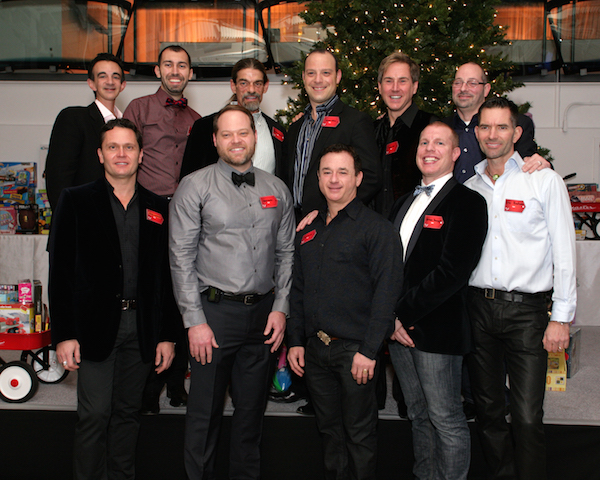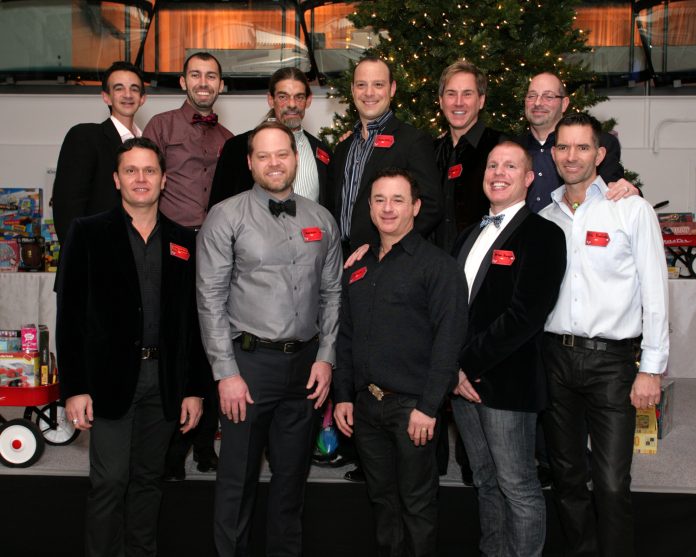By

NOTE: this story is adapted from a story written by Scott Kearnan about Toys for Joys’ 5th anniversary a year ago and ran in the Nov/Dec 2013 issue of Boston Spirit magazine. This year Toys for Joys is on Saturday, December 6, from 8 pm to 1 am at the Revere Hotel. Pre-registration is required. More information can be found here: www.toysforjoys.org.
By Scott Kearnan
Gay gifting group Toys for Joys celebrates fifth anniversary
If Santa Claus was gay, his Christmas party might look like this.
Picture it: piles of toys and holiday gifts stacked high, overflowing from cutesy red wagons, covered in every color of wrapping paper and ready for delivery to kids of all ages — from toddler girls to teenage boys. They’ve been assembled by hundreds of guests who now surround the haul, laughing and chatting, mingling and clinking glasses as they ring in the holiday season. Most of the gift givers, reflecting the constituency of the event organizers, also happen to be gay.
This is Toys for Joys.
“We identified a need, and now we do everything we can to help,” says James Rifino, the founder of Toys for Joys, which officially received 501c3 status this year.
The group has its roots in a small Christmas party held at Rifino’s home back in 2002, when an intimate group of guests brought toys and gifts to donate to needy kids via the Boston Housing Authority. But it wasn’t until 2007 that Rifino and his board of fellow gay professionals truly created a model for the kind of large-scale public bash it has become today.
The Toys for Joys celebration now attracts over 500 attendees annually, and has brought in nearly 10,000 toys for half a dozen different organizations: from the Multicultural AIDS Coalition to United South End Settlements.
What to make merry?
That’s what it’s all about, says board member Brian Bourquin. “There’s always a point in the night where a small group of us will look down at the crowd and all the toys and think, ‘we did it!’” says Borquin.
Borquin is no stranger to community-building: representing Boston on the Human Rights Campaign’s board of governors, he’s also responsible for wrangling the HRC’s annual local gala. But there’s something special about contributing to Toys for Joys, says Borquin. “There’s a political aspect to that work,” says Borquin. “But something like Toys for Joys just sells itself.”
And it functions as an A-list social gathering that gets everyone excited and on board. “If you go to Target the day before the event, it looks like a circuit party,” jokes Borquin of the lines of heaped red shopping carts.
Indeed, it’s hard to imagine anyone not wanting to support an event that single-handedly delivers thousands of toys to kids in need, which would explain why Toys for Joys manages to attract major sponsors: from Tito’s Handmade Vodka, which provides the beverages. And founder Rifino says that maintaining a somewhat apolitical approach is important to the event, even if also functions as a way to build bridges between its LGBT supporters and the greater community.
“The primary goal is to help kids,” says Rifino. He explains that opinions differ among Toys for Joys organizers regarding how emphatically the group should stress its LGBT identity to toy recipients. Some feel the efforts should be overt: say, stickers on each gift indicating its community association. Others, like Rifino, would rather take a more subtle approach and let the spirit of giving speak for itself.
“Many of us have had experiences in our own families where we’ve given something to children and had it thrown out because it was given by a gay person,” says Rifino. “We reach out to all the administrators [at benefiting organizations] and tell them that we would appreciate it if they would promote it, as they feel comfortable, that these donations came from the LGBT community. The kids may not know what that means, but their parents will. And it can make a difference in how the LGBT community is perceived.”
And though Toys for Joys is celebrating its sixth anniversary this year, organizers are continuing to think of new ways that the group can grow: from encouraging local businesses to sponsor (and fill) red wagons with gifts, to toying with the idea of a scholarship program that would help kids well beyond the holiday season. Those efforts can only continue to spread cheer and build positive connections.
But the biggest gift? That may go to the group itself. Explains Borquin: “There’s such a glow we feel afterward.” Let the yuletide glow. [x]









